The 27-inch Apple iMac Review (2011)
by Anand Lal Shimpi on May 27, 2011 2:30 AM ESTPower, Thermals and Noise
I started this review complaining about how loud the 15-inch MacBook Pro gets, but with 32x the physical volume the 27-inch iMac is near silent. Even under load the system is very quiet, almost too quiet. Apple chose a very lax fan profile which results in some very high external temperatures. The iMac takes in cool air from the bottom of the display and exhausts it up top behind the display. Playing Half Life 2 Episode Two I measured a maximum surface temperature of 125F at the exhaust vent. Again, unless you're doing something weird with the iMac on your lap this isn't an issue. Keep in mind that the Sandy Bridge CPU in the 15-inch MacBook Pro carries a 45W TDP and what's in the iMac is either 65W or 95W. Add in a larger, hotter hard drive and potentially a beefier GPU and you have a recipe for a pretty warm machine.
| 2011 iMac Power Usage | ||||||
| 27-inch iMac (Mid 2011) | Idle | Cinebench R11.5 | Half Life 2 Episode Two | |||
| Minimum Brightness | 54.1W | 108.3W | 149.0W | |||
| 50% Brightness | 86.6W | 141.6W | 180.0W | |||
| 100% Brightness | 144.5W | 198.3W | 240.0W | |||
With a large integrated display power consumption obviously varies depending on brightness. At idle, power consumption ranges from 54W to 144W. Under load the range quickly gets ever higher. I measured max system power consumption at 240W running Half Life 2 Episode Two.
Power consumption isn't out of control but you've got a billion transistor CPU, a 1.7B transistor GPU and a high resolution 27-inch display + backlight - it's going to draw some power.
Performance
Having never previously been a fan of the iMac, I don't actually have any historical performance data to compare to. What I do have however are scores from Mac Pros and of course the MacBook/MacBook Pro lines from the past couple of years.
Adobe Photoshop CS4 Performance
The Retouch Artists Speed Test we use for our CPU testing under Windows also works under OS X. We're running the exact same benchmark here, basically performing a bunch of image manipulations and filters and timing the entire process.
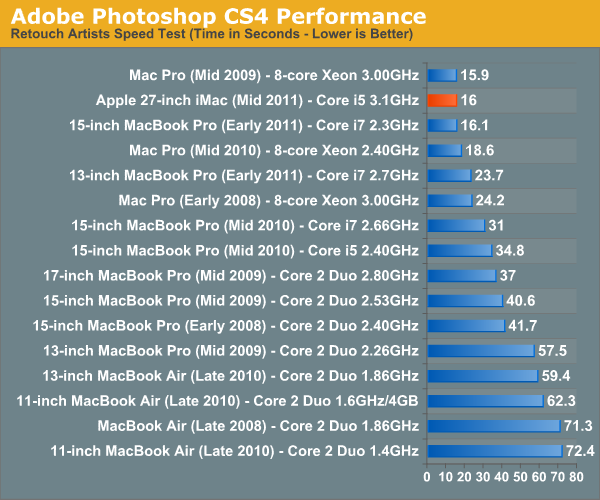
The high-end 27-inch iMac is a very capable Photoshop machine. A hair faster than the new MacBook Pro, the iMac delivers the same performance as an 8-core Mac Pro from 2009 or 2010.
Aperture 2 RAW Import
For my Aperture test I simply timed how long it took to import 203 12MP RAW images into the library.
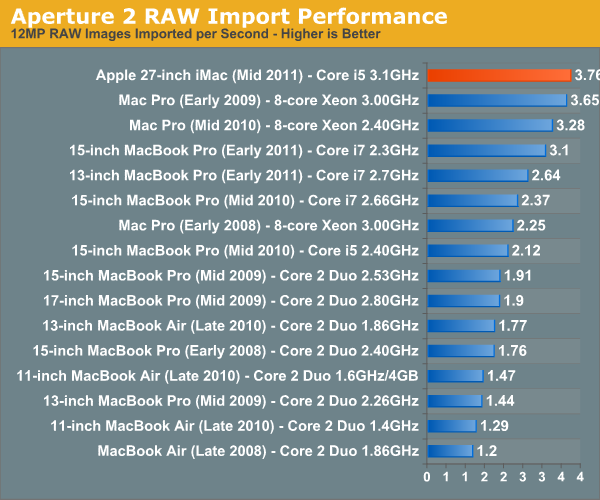
We have a new winner here! The MacBook Pros were always limited by their slower 2.5" hard drive, but the iMac with Sandy Bridge in additional to a speedier disk give us better image import performance than the '09 and '10 Mac Pros. I told you this thing was fast.
Cinebench R10 & 11.5
I’m a fan of the Cinebench tests because they lets me show off both single and multithreaded performance in the same workload. First, the single threaded performance:
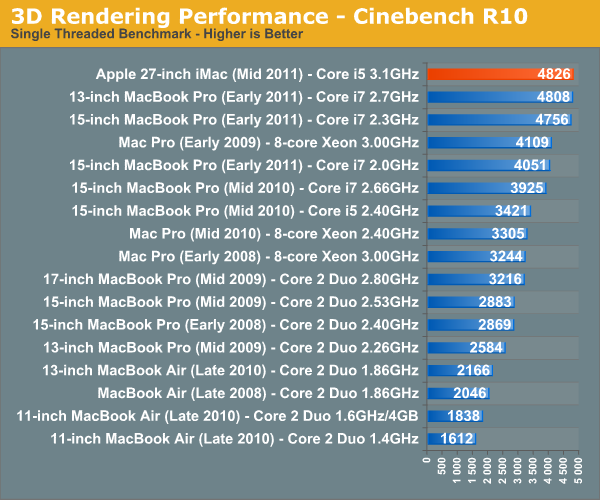
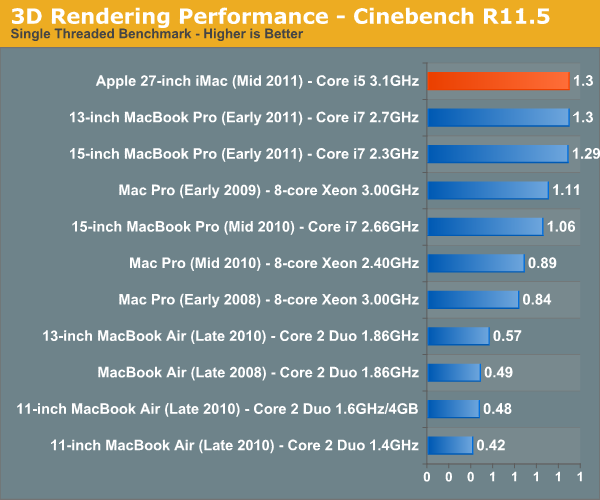
Sandy Bridge quad-core CPUs make no sacrifices. You get excellent single threaded performance which means general OS usage, launching applications and even rendering most web pages happens as fast as physically possible as the other cores are power gated and asleep. Start multitasking however and you'll see the Core i5 in this machine is no slouch:
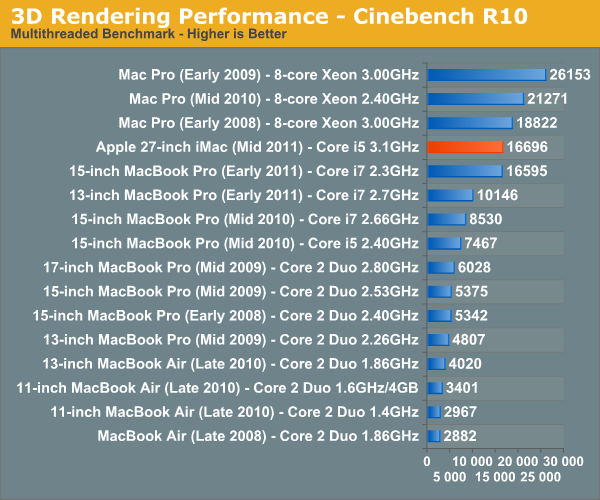
There's still no replacement for more cores when it comes to heavily threaded applications, the past three years of 8-core Mac Pros are still faster than the new 27-inch iMac here. I suspect the upgraded Core i7 would at least let the iMac beat the 2008 Mac Pro thanks to Hyper Threading, but the other two systems are simply out of reach. For those users, you're better off waiting for the Sandy Bridge-E Mac Pro update expected sometime in Q4.
You'll notice in Cinebench R10 the 15-inch MacBook Pro is nipping at the heels of the new iMac. Chalk that up to the larger L3 cache and Hyper Threading, both advantages enjoyed by the MacBook Pro. Look at what those advantages do in Cinebench R11.5's multithreaded test:
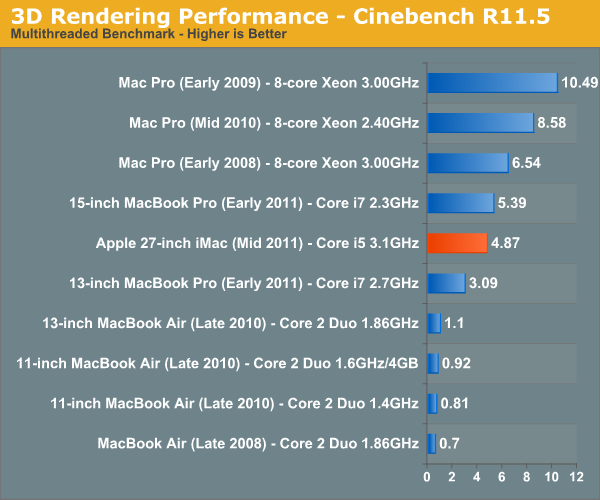
Here the MacBook Pro actually gains on the iMac. More threads and more cache are better suited for the Cinebench workload. If you do a lot of offline 3D rendering and you want the iMac, I'd suggest upgrading to the Core i7-2600 that Apple offers. You get a not insignificant boost in clock speed but more importantly, Intel switches on Hyper Threading which gives you twice as many threads.
Quicktime H.264 Video Encoding
Our final benchmark is more consumer focused. Here I'm taking an XviD and converting it to an iPhone-supported H.264 format.

QuickTime doesn't make tremendous use of all cores all of the time, and thus the MacBook Pro loses its threading advantage. The iMac is our new champion of this test.










139 Comments
View All Comments
KoolAidMan1 - Friday, May 27, 2011 - link
"The example given by headbox is a prime example."I can't think of any Mac user who would really try this. I mean, I plug my gaming PC into my 27" iMac as a primary display through the mini-DP port, and I figure I'm in an extreme minority of users. People who plug consoles and BR players and who would need a converter box is be an even tinier number of users.
Don't get me wrong, I'm annoyed that the 2011 iMac has new Target Display Mode requirements, but the limitations of prior models in terms of using set-top boxes (consoles, Blu Ray players) isn't statistically a big enough number to get bent out of shape over, IMHO.
Tros - Friday, May 27, 2011 - link
"How are you going to upgrade the motherboard on a proprietary and overpriced all in one?"This is as much of a criticism on laptops, tablets, smartphones, as all-in-one units. And guess what: That proprietary junk has been of great value to a lot of people, especially if it has an aesthetic appeal.
Penti - Friday, May 27, 2011 - link
While certainly great for what they for probably, it's definitively not the same thing using 23" 1920x1080 120Hz TN-screens with Nvidia 3D Vision as with a good IPS or PVA screen with proper viewing angles and for mostly other uses then gaming. Of course you need your PC to your triple display gaming machine and a strong GPU too.rubaiyat - Wednesday, September 7, 2011 - link
Do you actually use your computer for much besides gaming?I'd rather have an excellent monitor than some dodgy and essentially useless 3D 'feature'.
But that separates consumers in all areas. Those who will see a movie because it has (very loud) surround sound and pseudo 3D with lots of explosions, and those who will see a movie because it actually IS a good movie.
My iMac27 has a brilliantly sharp and accurate 27" 2540x1920 display, that thankfully is not 3D nor runs generally awful Windows grade video.
nafhan - Friday, May 27, 2011 - link
I'm fine spending more on a monitor than a desktop... However, I'll usually go through two or three desktop hardware upgrades before I replace my monitor.fitten - Friday, May 27, 2011 - link
And when the monitor is the majority of the cost of the system, it makes sense to reuse it for future upgrades. Monitor technology seems to evolve slower than the rest of the system so barring some major changes, keeping it for several upgrades won't 'set you behind' any. So, reusing a monitor is an extremely cost efficient technique to keep your computer 'modern'.Spivonious - Friday, May 27, 2011 - link
Exactly. I've had the same NEC (Mitsubishi tube) CRT on my desk for 15 years. The picture is still fantastic and blows any TN-panel LCD out of the water.KoolAidMan1 - Friday, May 27, 2011 - link
Good thing they use the best IPS panels in these things. :)Guspaz - Friday, May 27, 2011 - link
Colour-reproduction wise, perhaps, although that depends on the backlight. In terms of detail and a crisp image, even a cheap TN panel will destroy an old CRT, and IPS panels will match or surpass such a CRT.I'm reminded of a friend of mine, who for years (until perhaps 2-3 years ago) insisted that his old CRT monitor was fine, despite the fact that it was so out of focus that 14 point text was unreadable. He finally relented and upgraded when we proved to him that he was in denial when we realize that the reason he didn't have trouble reading on the monitor was because he increased the text size by 200-300% when he used the monitor. Now, I'm not suggesting that your monitor is out of focus, a good CRT monitor can have excellent sharp detail. But even the best of them comes nowhere close to a half decent LCD.
KoolAidMan1 - Friday, May 27, 2011 - link
Not at all. Sell the iMac and get a better monitor that comes in the next update, it happens every 2-3 years. Resale value is also high.